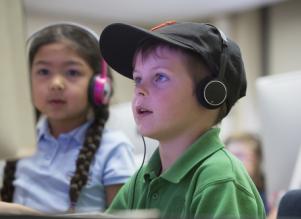7/22/2025
Teaching Multiple-Meaning Words: A Key Strategy For Unlocking Meaning
by Julie Russ Harris, Ed.M.
Elementary Curriculum Specialist, Lexia
Ms. Hoye and a small group of second-grade students sit around a kidney-shaped table. The students whisper-read from individual copies of the same book—about life in the ocean—moving along at their own pace.
“Ms. Hoye–” Isaiah looks up. “What does this say?” He points to the word school. After several prompts to support Isaiah’s word-solving skills, Ms. Hoye tells him, “the word is school.” She then reads the full sentence, “The school of fish swim together.” Isaiah furrows his brow. “But that doesn’t make sense!” Now it is Ms. Hoye’s brow that furrows...
Multiple-meaning words (perhaps it goes without saying) are words that have more than one meaning. Our everyday conversations are filled with these words; many are deceivingly simple terms like pen and mine. And, as Isaiah found, these words are embedded in texts of all kinds: from leveled readers to trade books to informational articles. Multiple-meaning words are messy, unavoidable, and can be confusing. But at the same time, these words provide rich instructional opportunities.
Why are multiple-meaning words a strong platform for teaching and learning? Well, readers need to develop and practice linguistic flexibility: the ability to understand and use words in a variety of ways. Successful comprehension relies on deep knowledge of words’ multiple meanings, and successful comprehension monitoring depends on a readiness to appropriately adjust interpretations of words to fit the context.
But recognizing the importance of teaching multiple-meaning words is one thing and integrating effective multiple-meaning-word instruction into packed literacy blocks is another. The following principles for teaching multiple-meaning words are meant to provide a springboard for instructional planning. Here, the learning of multiple-meaning words is viewed not as a standalone skill to be mastered, but as an integral component of a larger vocabulary-learning process.
Setting the stage: Content matters
Strong vocabulary instruction—including instruction focused on multiple-meaning words—is organized within content-based units of study. Why? The words we teach need to be connected to something; ideally, this is a rich thematic unit focused on a multifaceted, academic topic with significant potential for student engagement. Whether it’s a science topic (e.g. how animals survive in extreme environments), a social studies topic (e.g. how the past influences our lives today), or a social-emotional topic (e.g. what makes a strong team), rich content is a cornerstone of quality vocabulary-learning opportunities.
Choosing words: Multiple meanings and beyond
For each content-based unit of study, choose a small set of useful and complex vocabulary terms from texts students are reading and listening to. Within this set, a subset of terms should have multiple meanings. These words should be both relevant to the unit at hand and useful in academic contexts more generally. For example, in a unit about how animals survive in extreme environments, multiple-meaning terms might include more general-purpose academic vocabulary like structure as well as more subject-specific terms like scales.
Teaching and learning: From words to strategies
When teaching multiple-meaning words, the initial focus will be on how the terms are used in the texts in which they are first encountered. But after this initial teaching and learning, each unit of study might be punctuated by an explicit focus on the terms’ multiple meanings. These words, then, become a platform for supporting students to approach and use words with flexibility as a more generalized strategy.
Strong learning activities take a variety of modes and formats, and systematically join explicit instruction with playful practice and application in meaningful contexts. Here are a few ideas for teaching the concept of multiple-meaning words and helping students put linguistic flexibility to use in context.
Discuss familiar example words (e.g. duck, tag, fan) with students, directly reviewing less common multiple meanings as necessary. Then, provide opportunities for students to decide which meaning is being used in a particular sentence (e.g. The duck shook his feathers to dry off or We can hide if we duck behind that rock).
Support students in keeping track of multiple-meaning words in their vocabulary journal. They should make note of these words in the unit of study, along with their meanings, pictures that represent those meanings, and example sentences.
Play word games that ask students to recognize words’ multiple meanings. For example, create—or have students illustrate—pairs of cards to tell or show two meanings of a specific word. Use the cards to play a matching game. Students should collect both pictures for a word and give a verbal definition of each picture.
Have students use the multiple-meaning words they are studying in their talk and writing. For example, ask thematically relevant questions for pairs or groups to discuss. Purposefully use multiple-meaning terms as part of the questions, or embed these terms in language frames used to support students’ responses. In addition to discussing the content at hand, get metacognitive about the target multiple-meaning words—discuss how the multiple-meaning word is used in these conversations and how students can decipher which meaning of the term fits the context.
Ms. Hoye and Isaiah’s experiences at the guided-reading table are not unique ones. Language is messy, and teaching (and learning) language is a process rather than a destination. Embrace the mess and joyfully enter the mire of multiple-meaning words. It’ll be fun!


